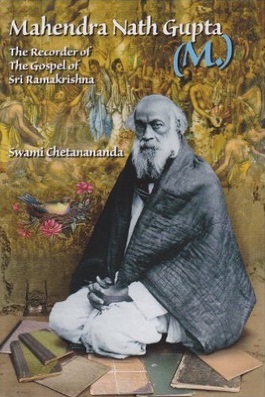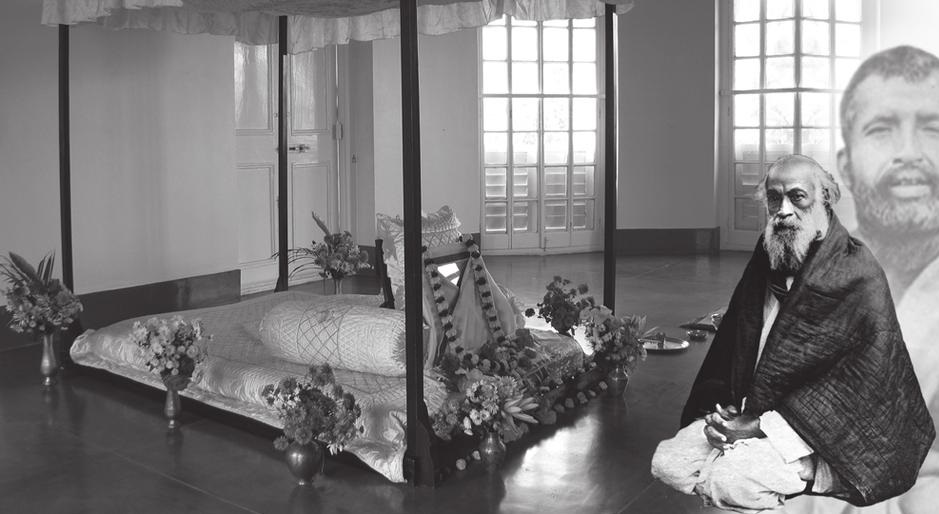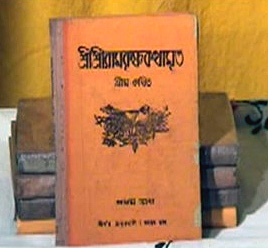Mahendranath Gupta

M. was the pen name of Mahendra Nath Gupta (1854-1932), the headmaster of Vidyasagar’s High School in Calcutta. M. met Sri Ramakrishna in 1882 and recorded in his diary many of the Master’s conversations and teachings until the latter’s passing away in 1886. Excerpts from this diary were first published in Bengali in five volumes under the title Sri Sri Ramakrishna Kathamrita.
In 1942 Swami Nikhilananda translated this into English and combined the five volumes into one, entitled The Gospel of Sri Ramakrishna. In his later life M. was surrounded by devotees, and his conversations with them about Sri Ramakrishna and spiritual life were recorded by Swami Nityatmananda from 1923 to 1932. These conversations were published in Bengali in sixteen volumes under the title: “Srima Darshan”.
The following is an excerpt from a biography of Mahendranath Gupta
by Swami Nityatmananda. P.1967

It was during the life-time of Sri Ramakrishna that M was the first of the devotees to visit Kamarpukur, his native village. By the grace of Thakur, he saw the entire Kamarpukur as a holy-place bathed in effulgent light. Trees and creepers, beasts and birds, and men – all were made of effulgence.
So, he prostrated to all on the road. He came across a tom-cat made of light. He immediately fell on the ground and saluted it. Another day, he saw the holy Dakshineshwar enveloped in light. Instead of going himself, Thakur sent M to Puri. He said, “If I go there I shall not survive in this body.” – By the memory of his play as Sri Chaitanya he might enter into mahabhava and might quit this mortal frame. At the instances of Thakur, with indomitable courage, M embraced Jagannath out of season. Later on too, M visited Puri several times.
His first visit to Kashi was when he was only sixteen. Seeing Kashi from the railway bridge, the mind and soul of M began to dance in unison with joy. He again visited Kashi several times. After the demise of Thakur, he met Trailanga Swami, Bhaskarananda Swami and Vishuddhananda Swami. When Bhaskarananda Swami heard the Mother’s Song of Thakur, sung by M he said, “You say you have to do so many things. How do you find time to think on these sublime thoughts?” Trailanga Swami snatched the basket of sweets from the hands of M and like a child hid it behind his back.
In Ayodhya, Raghunath Babaji consoled M saying, “Visit the place of the guru, meditate on the name and form of the guru, sing the praises of the guru and live.” In Vrindavan, M witnessed the Jhulan festival, the festival of the swing, and in Nidhuvana, he sought the place of Ganga Mai, visited by Thakur. The acting of the rasadharis enchanted M.
M accompanied Holy Mother to Kashi in 1912. He spent this year and the next in the Uttarakhanda in tapasya. He underwent tapasya on the bank of the Ganga at Kanakhal in Haridwar, living in a hut. At times, in that hut, he would form the brahma-chakra, alongwith his brother disciples – Swami Turiyananda, Swami Shivananda and others. Then he went to Rishikesh. At first, he lived at Mayakunda, later he shifted to a hut in the Swarga-Ashrama. To this day, this hut exists but in a dilapidated condition.
Within M, there always resided a rishi of the highest order devoted to the life of tapasya in the tapovana. He nursed a burning desire all his life to live in a tapovana. In his own residence, in Calcutta, in the Morton School and the Thakur Bari, he grew various kinds Of fruits and flower-plants in flowerpots and tubes on the roof of the building. If a man would listen to the chanting of the Upanishad from the lips of M sitting there, in the sober and grave Vedic tune, he would be reminded perforce that a rishi of the Satyayuga had perhaps descended in a new body.
The Upanishad was the life and soul of M; next came the Gita. Of the Bible, he was a master. In the course of conversations, always without cessation he would quote divine passages from these three scriptures. Hearing the interpretations of the Biblical text from the lips of M, an old orthodox devout padre Mr. Bose, his neighbour, would be struck dumb. With a smile, M would reply: Thakur and Christ are one. – Hinting at it – Because I lived with Christ in the same house, so I am able to comprehend a little of his word.
Those unmarried young men who would embrace the monastic life, M would love with a hundred mothers’ heart. As parents become free from anxiety when they can make their son stand on his own feet, exactly so was the case with M. He would be free from anxiety when he saw the devotees surrendering themselves to Sri Ramakrishna. The company of the sadhus and the service of the sadhus – this is the practical Vedanta and he always taught it to the sadhus and bhaktas.
M was always surrounded by sadhus and bhaktas. Like Thakur, he also considered the sadhus and bhaktas as his own near and dear ones and looked upon his kith and kin as strangers. Even when he was going to enter into mahasamadhi he forbade the attendant-brahmachari to inform the members of his family. They arrived by being informed by the neighbours.
M had two sons, two daughters and a vast family circle. Having done all his duties, he was a stranger, as it were, in his own house – a pilgrim, as it were, in an inn. He revered the members of the family of Thakur and the paternal family of Holy Mother like Thakur himself. He would look upon even the inhabitants of their birth-places in the same light. He looked upon Thakur and Holy Mother as one and indivisible. His brother and sister disciples were like the guru to him. A pommelo orange – chakotra – fruit of the Belur Math garden and a bael of the Dakshineshwar, M treasured as sacramental offerings from Vaikuntha.
The terrace of the third storey of Morton School and the staircase-room were like the Naimisharanya – always resounded with the holy words of God. Like Rishi Narada, M would sing the glory of Sri Ramakrishna with a thousand tongues. Broach any topic you like and M would drown it without the knowledge of others into the ocean of nectar of Sri Ramakrishna, the harbinger of blissful comfort to the soul. If ever anybody spoke ill of the sadhus before M, lo! there was no escape for him, he would make him bathe in the tears of his eyes by sweet admonition. M would say, “Man is made up of good and bad.” In spite of their defects, the sadhus are adorable to us. If we speak ill of them where shall we go to listen to the word of God? Once for several years, he sent devotees every morning to the Belur Math by the first steamer for the company of sadhus.
The swan in M sifted virtues. The doors of finding fault with others remained sealed for ever for him. The pride of birth, education, wisdom, beauty and virtue were totally uprooted in his life.
It was for the publication and propagation of the Kathamrita that M was born. The writing of the fifth part was finished at nine in the night. Immediately after, started neuralgic pain. Under this pretext:, with this swan-song on his lips: ‘Gurudeva Ma, kole toole na-o’ – Master, O Holy Mother, take me in your lap, M. whose life was completely given to Sri Ramakrishna entered maha-samadhi. It was June 4, 1932 A. D. Saturday, at the end of the Phalaharani Kali worship, on the last day of the Dark Fortnight in the Rohini Nakshatra.
It was twenty-one days before that M had started on the journey, chanting the name of Durga and sat waiting, and pouring out his soul, sang the farewell death-conquering victory song – “I have surrendered my soul at the feet of the Fearless One and what fear is there for me from the god of death?”

The Cover of 5 Volumes of Sri Sri Ramakrishna Kathamrita



